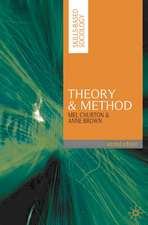The Analysis of Change
Editat de John Mordechai Gottmanen Limba Engleză Paperback – sep 1995
The field of methodology for the study of change is itself ready to change. Recently, there have been many analytic and conceptual developments questioning our cherished beliefs about the study of change. As such, how are individuals to think about issues and correctly analyze change? The chapters in this volume address these issues.
Divided into two sections, this book deals with designs that analyze change in multiple subjects, and with change in single subjects and an interacting system. Papers presented in this volume are accessible to scientists who are not methodologists. The character of the papers are more like primers than basic treatises on methodology, written for other methodologists. It is time that people stop thinking in rigid ways about how to study change and be introduced to a range of many possibilities. Change, stability, order and chaos are elusive concepts. The pursuit of the laws of change must be approached in as flexible and creative a fashion as possible. This book should help to lead the way.
Preț: 678.96 lei
Preț vechi: 798.78 lei
-15% Nou
Puncte Express: 1018
Preț estimativ în valută:
129.93€ • 134.83$ • 108.60£
129.93€ • 134.83$ • 108.60£
Carte tipărită la comandă
Livrare economică 15-29 martie
Preluare comenzi: 021 569.72.76
Specificații
ISBN-13: 9780805813579
ISBN-10: 0805813578
Pagini: 544
Ilustrații: Illustrations
Dimensiuni: 152 x 229 x 28 mm
Greutate: 0.7 kg
Ediția:1
Editura: Taylor & Francis
Colecția Psychology Press
Locul publicării:Oxford, United Kingdom
ISBN-10: 0805813578
Pagini: 544
Ilustrații: Illustrations
Dimensiuni: 152 x 229 x 28 mm
Greutate: 0.7 kg
Ediția:1
Editura: Taylor & Francis
Colecția Psychology Press
Locul publicării:Oxford, United Kingdom
Public țintă
ProfessionalCuprins
Contents: Preface. Part I: Analyzing Change in Multiple Subjects. D. Rogosa, Myths and Methods: "Myths About Longitudinal Research" plus Supplemental Questions. G.P. Sackett, J.W. Shortt, Hierarchical Regression Analysis with Repeated Data Measures. G.R. Patterson, Orderly Change in a Stable World: The Antisocial Trait as a Chimera. M. Stoolmiller, Using Latent Growth Curve Models to Study Developmental Processes. E.R. Anderson, Accelerating and Maximizing Information from Short-Term Longitudinal Research. S.W. Raudenbush, Hierarchical Linear Models to Study the Effects of Social Context on Development. J.B. Willett, J.D. Singer, Investigating Onset, Cessation, Relapse, and Recovery: Using Discrete-Time Survival Analysis to Examine the Occurrence and Timing of Critical Events. M. Stoolmiller, L. Bank, Autoregressive Effects in Structural Equation Models: We See Some Problems. Part II: Analyzing Change in a Single Subject or an Interacting System. R. Bakeman, L.B. Adamson, P. Strisik, Lags and Logs: Statistical Approaches to Interaction (SPSS Version). W.A. Griffin, Assessing State Changes in Micro-Social Interaction: An Introduction to Event-History Analysis. W. Gardner, On the Reliability of Sequential Data: Measurement, Meaning, and Correction. J. Crosbie, Interrupted Time-Series Analysis with Short Series: Why It Is Problematic; How It Can Be Improved. M.B. Priestly, Current Developments in Time-Series Modeling. J. Murray, Nonlinear Dynamics and Chaos. G.L. Baker, The Chaotic Pendulum: Model and Metaphor.
Recenzii
"This book focuses on the more difficult but richer designs and analysis of change that occur within a unit over time. It easily qualifies as a necessary reference for any serious methodologist faced with the issues of measuring change over time."
—Contemporary Psychology
—Contemporary Psychology
Descriere
Divided into two sections, this book deals with designs that analyze change in multiple subjects, and with change in single subjects and an interacting system. Papers presented in this volume are accessible to scientists who are not methodologists. The character of the papers are more like primers than basic treatises on methodology, written for other methodologists. It is time that people stop thinking in rigid ways about how to study change and be introduced to a range of many possibilities. Change, stability, order and chaos are elusive concepts. The pursuit of the laws of change must be approached in as flexible and creative a fashion as possible. This book should help to lead the way.














